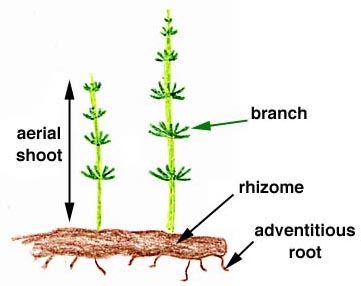EQUISETUM
The genus Equisetum is represented by fifteen species and five hybrids. They are herbaceous plants that are unique in that they have silica in their cell walls, giving it a sandpapery texture which made it useful as a scouring pad for early settlers and aboriginal peoples, and thus the common name ‘scouring rush’.
Other conspicuous characteristics of the genus include its arrangement of branches and reduced leaves (often scale-like) in whorls at the nodes of the hollow, jointed stem, its silicified epidermal cells, and its sporangia organized into conspicuous strobili. Equisetum is homosporous with small, photosynthetic gametophytes. There have been some reports that a mycorrhizal association may exist in some non-photosynthetic species.
Equisetum plants reproduce vegetatively by means of a shallow rhizome which gives rise to shoots and adventitious roots. Even the smallest of fragments can develop into a new colony of plants. The roots and shoots grow from regular nodes, and branches are also at nodes.
GENUS
STEM and LEAVES
STROBILUS


